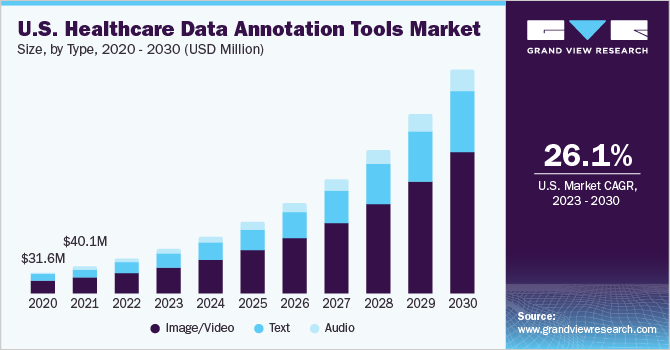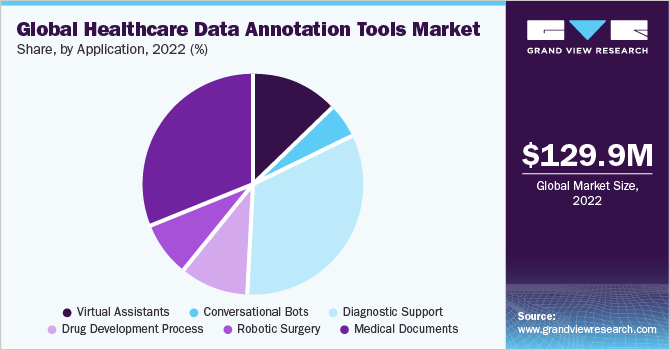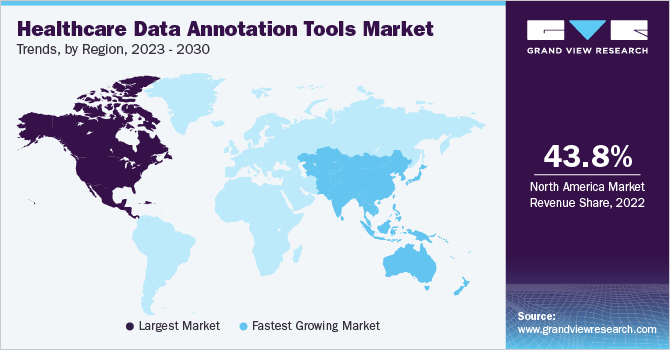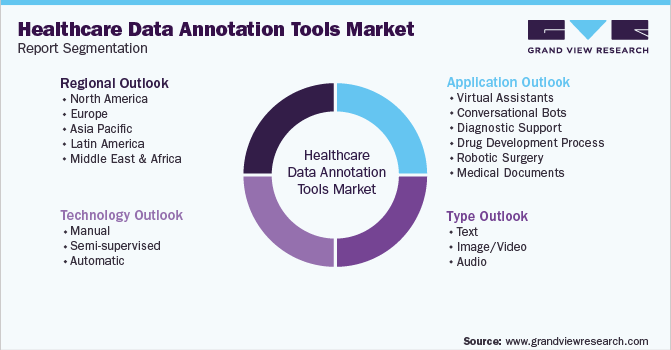
Healthcare Data Annotation Tools Market Size, Share & Trends Analysis Report By Type (Text, Image/Video, Audio), By Technology, By Application, By Region, And Segment Forecasts, 2023 - 2030
- Report ID: GVR-4-68040-050-0
- Number of Pages: 100
- Format: Electronic (PDF)
- Historical Range: 2018 - 2021
- Industry:Healthcare
Report Overview
The global healthcare data annotation tools market was valued at USD 129.9 million in 2022 and is expected to expand at a compound annual growth rate (CAGR) of 27.5% from 2023 to 2030. Thedata annotation toolsin healthcare sector are reshaping the diagnosis, treatment, and patient monitoring by significantly improving healthcare research and outcomes by generating precise diagnosis and enabling enhanced personalized treatments. These tools help in analyzing vast amount of clinical documentation by healthcare professionals to quickly identify disease markers. The potential applications of these tools include scanning radiological images for early detection of diseases to predict results fromelectronic health records.

Annotation generates high-quality data to train the AI/ML models in healthcare sectors to accelerate the search for biological and chemical interactions, which is useful in drug development. Analyzing a huge volume of data from patient records, clinical trials, patents, and research papers can accelerate the development of new drugs. In addition, data annotation can also make billions of inferred relationships among candidate drugs, species, tissues, symptoms, diseases, and genes. Moreover, specialized annotation teams label critical structures in millions of frames in surgical videos to perform computer vision-driven autonomous robotic surgery to enable safer and better treatments. Hence, increasing applications of these tools and growing adoption of AI/ML technologies in healthcare sector are propelling the market.
Moreover, the advantages ofeHealthandtelemedicineservices, such as easy availability of health services, cost savings, and improvement in diagnostics & treatment services are anticipated to boost the investments ondigital healthand other eHealth-related service. For instance, in September 2020, Aidoc raised USD 20 million in Series B funding round led by Square Peg Capital to aid in the development of AI-based digital imaging & radiology offerings. In addition, increase in number of initiatives supporting eHealth and digital health is expected to drive the market in the forecast period. For instance, in May 2022, the European Health Data Space Program was unveiled to support the use of health data for improvements in research, innovative healthcare delivery, and policymaking.
此外,一些市场参与者introducing technologically advanced tools to meet the untapped opportunities in the market. For instance, in January 2023, CloudFactory introduced Accelerated Annotation, a Vision AI product that fuses industry-leading AI-assisted labeling technology with CloudFactory’s workforce to generate high-quality labelled data five times faster compared to manual labelling. Similarly, in October 2022, Google launched Medical Imaging Suite tools to create training datasets and automated image labeling through AI-assisted annotation. The Medical Imaging Suite aids in quicker and accurate diagnosis than human clinicians, while decreasing the workload on radiologists. These strategic initiatives by major companies are likely to boost the adoption of these software solutions in healthcare during the study period.
Type Insights
By type, the image/video segment held the largest share of 60.4% in 2022 and is anticipated to exhibit the rapid CAGR during the forecast years.This is attributed to the large scale-adoption of image/video data annotation tools in medical filed along with the increasing need for efficient and cost-effective solutions for medical diagnosis. These tools are used in the creations of visualizations of specific organs to diagnose unusual defects in the human body that cannot be identified with naked eye. In cancer, image annotation is used to train AI models to predict cancer using labelled cancer image data. This decreases the possibility of human error and helps in the early detection of various types of cancers.
Furthermore, in dental imaging, labelled X-ray image data is used to visualize teeth structure and detect tooth cavities, gum diseases decay, and other abnormalities. Moreover, the video data annotation in healthcare facilitates various medical task such as surgery. Automated surgical bots are also trained with video annotation to assist surgical procedures and endoscopy including phase identification, & lesion detection. Such, capabilities are driving the image/video segment. Key players in the market are continuously launching novel image/video annotation tools for healthcare industry, thereby propelling the segment. For instance, in April 2022, Encord introduced DICOM image annotation tool for healthcare AI that allows users to run and train models to automate medical image annotation in 3D for modalities includingMRI, CT, and X-ray to eradicate manual data labelling.
Technology Insights
By technology, the semi-supervised segment held the largest share of 39.8% in 2022. Based on technology, the market is categorized into manual, semi-supervised, and automatic. The semi-supervised technology uses small amount of labelled and large amount of unlabeled data. This can reduce the expenditure on manual data annotation and cut data preparation time. Since unlabeled data is abundant, inexpensive and easy to get, semi-supervised technology finds various applications, thereby boosting the segment. For instance, early diagnosis of dental caries using a semi-supervised technology can enable preventive treatment and prevent invasive treatment. According to a an article published by Springer Nature Limited in 2023,the semi-supervised methods have been successful in detection of dental caries and have provided competitive results as compared to fully supervised learning methods.
自动部分预计将见证rapid growth in the forecast period. This is attributed to the increasing prominence of quicker and cost-effective data labelling and delivery of annotated data. AI is becoming vital to this industry as the technology allows the extraction of complex and high-level abstractions from the datasets using a hierarchical learning process. The need for extracting and mining meaningful patterns from voluminous healthcare data is driving the growth of AI, which is expected to further drive the demand for automatic tools during the forecast period.
Application Insights
By application, the diagnostic support segment held the largest share of 32.9% in 2022. Data annotation tools in diagnostic support aid in the identification and rectification human errors in X-rays, ultrasound scans, MRI and CT. These tools can increase the accuracy and speed by lowering the costs. For instance, data annotation tools can aid AI models to detect COVID-19 pneumonia and execute embryo classification. In addition, these software tools allow the early diagnosis of various chronic diseases such as cancer by using AI. For instance, thermal sensors with AI can identify breast cancer by visually displaying the amount of infrared energy emitting from tumor. Thus, diagnostic support offered by healthcare data annotation tools in diagnosis of various chronic and infectious diseases is boosting the segment.

The virtual assistant segment is anticipated to witness fastest growth in the forecast period. The virtual assistants in healthcare system accelerate the detection of illness, raise reminders for medication, monitors health status and schedules doctor appointments to reduce waiting time. Moreover, virtual assistants have several advantages such as better patient experience, boosted productivity, decreased employment cost up to 70%, sustainable growth, and lowered likelihood of becoming burn out. Therefore, several benefits offered by virtual assistants are expected to boost the segment during the study period.
Regional Insights
In 2022, North America dominated the market with a share of 43.8%. The large share can be attributed to the high healthcare expenditure coupled with growing acceptance of advanced technologies including AI, machine learning, big data, cloud and IOT. In addition, increased usage of mHealth, e-prescribing, telehealth, and other healthcare IT technologies as a response to COVID-19, as well as increased government support & requirements for advanced AI/ML solutions in healthcare, are the primary growth factors fuelling the market. Moreover, rise in adoption of electronic health records is significantly increasing in the region. According to the Health IT reports until 2021, nearly 9 out of 10 U.S.-based physicians have adopted EHR. Therefore, high adoption rate also plays a key role in driving market growth in North America.

Asia Pacific is anticipated to witness fastest growth in the forecast period. This is due to an increasing healthcare expenditure in emerging Asian economies and the improvement in healthcare capabilities. In addition, rising adoption of advanced technologies such as AI/ML to lower the medical costs & streamline hospital workflow, are the major drivers of healthcare data annotation tools in the region. Furthermore, numerous government initiatives and supportive programs are also driving the adoption of these software solutions in the region. For instance, The National Health & Family Planning Commission (NHFPC) of the People’s Republic of China established the Chinese Jinwei Network Engineer to promote the development of telemedicine in the country.
Key Companies & Market Share Insights
Various strategies such as expansions, investments, funding’s, partnerships, and product development, etc. adopted by operating players is driving the market. For instance, in March 2023,Shaip, a leading provider of platforms and services in AI Data industry has expanded its operations by opening a new workplace in India. This initiative is expected to boost the company’s offerings in healthcare data annotation tools. Some prominent players in the global healthcare data annotation tools market include:
Infosys Limited
Shaip
Innodata
Ango AI
Capestart
Lynxcare
iMerit
Anolytics
V7
SuperAnnotate LLC
Healthcare Data Annotation Tools Market Report Scope
Report Attribute |
Details |
Market size value in 2023 |
USD 167.4 million |
Revenue forecast in 2030 |
USD 916.8 million |
Growth rate |
CAGR of 27.5% from 2023 to 2030 |
Base year for estimation |
2022 |
Historical data |
2018 - 2021 |
Forecast period |
2023 - 2030 |
Quantitative units |
Revenue in USD million and CAGR from 2023 to 2030 |
Report coverage |
Revenue forecast, company ranking, competitive landscape, growth factors, and trends |
Segments covered |
Type, technology, application, region |
Regional scope |
北美;欧洲;亚太地区;拉丁美洲; MEA |
Country scope |
U.S.; Canada; U.K.; Germany; France; Italy; Spain; Denmark; Norway; Sweden; China; Japan; India; South Korea; Australia; Thailand; Brazil; Mexico; Argentina; South Africa; Saudi Arabia; UAE; Kuwait |
Key companies profiled |
Infosys Limited; Shaip; Innodata; Ango AI; Capestart; Lynxcare; iMerit; Anolytics; V7; SuperAnnotate LLC |
Customization scope |
Free report customization (equivalent up to 8 analysts working days) with purchase. Addition or alteration to country, regional & segment scope. |
Pricing and purchase options |
Avail customized purchase options to meet your exact research needs.Explore purchase options |
GlobalHealthcare Data Annotation Tools Market ReportSegmentation
This report forecasts revenue growth at the global, regional, and country levels and provides an analysis of the latest industry trends and opportunities in each of the sub-segments from 2018 to 2030. For this study, Grand View Research has segmented the global healthcare data annotation tools market report based on type, technology, application, and region:

Type Outlook (Revenue, USD Million, 2018 - 2030)
Text
Image/Video
Audio
Technology Outlook (Revenue, USD Million, 2018 - 2030)
Manual
Semi-supervised
Automatic
Application Outlook (Revenue, USD Million, 2018 - 2030)
Virtual Assistants
Conversational Bots
Diagnostic Support
Drug Development Process
Robotic Surgery
Medical Documents
Regional Outlook (Revenue, USD Million, 2018 - 2030)
North America
U.S.
Canada
Europe
U.K.
Germany
France
Italy
Spain
Sweden
Norway
Denmark
Asia Pacific
Japan
China
India
South Korea
Australia
Thailand
拉丁美洲
Brazil
Mexico
Argentina
MEA
South Africa
Saudi Arabia
UAE
Kuwait
Frequently Asked Questions About This Report
b.The global healthcare data annotation tools market size was estimated at USD 129.9 million in 2022 and is expected to reach USD 167.4 million in 2023.
b.The global healthcare data annotation tools market is expected to grow at a compound annual growth rate of 27.5% from 2023 to 2030 to reach USD 916.8 million by 2030.
b.The diagnostic support dominated the application segment with the share of 32.9% in 2022. Data annotation tools in diagnostic support aid in the identification and rectification human errors in X-rays, ultrasound scans, MRI and CT. These tools can increase the accuracy and speed by lowering the costs. For instance, data annotation tools can aid AI models to detect COVID-19 pneumonia and execute embryo classification. In addition, these software tools allow the early diagnosis of various chronic diseases such as cancer by using AI.
b.Some key players operating in the healthcare data annotation tools market include Infosys Limited, Shaip, Innodata, Ango AI, Capestart, Lynxcare, iMerit, Anolytics, V7, SuperAnnotate LLC
b.Key factors that are driving the market growth include growing adoption of AI/ML-based technologies for medical diagnosis, rising healthcare funding and investments prompting cost-cutting initiatives, increase in number of initiatives supporting eHealth and digital health and technological advancements of data annotation tools





